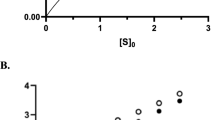Abstract
A graphical method for analyzing enzyme data to obtain kinetic parameters, and to identify the types of inhibition and the enzyme mechanisms, is described. The method consists of plotting experimental data as v/(V o-v) vs 1/(I) at different substrate concentrations. I is the inhibitor concentration; V o and v are the rates of enzyme reaction attained by the system in the presence of a fixed amount of substrate, and in the absence and presence of inhibitor, respectively. Complete inhibition gives straight lines that go through the origin; partial inhibition gives straight lines that converge on the 1-I axis, at a point away from the origin. For competitive inhibition, the slopes of the lines increase with increasing substrate concentration; with noncompetitive inhibition, the slopes are independent of substrate concentration; with uncompetitive inhibition, the slopes of the lines decrease with increasing substrate concentrations. The kinetic parameters, K m, K i, K′i, and β (degree of partiality) can best be determined from respective secondary plots of slope and intercept vs substrate concentration, for competitive and noncompetitive inhibition mechanism or slope and intercept vs reciprocal substrate concentration for uncompetitive inhibition mechanism. Functional consequencs of these analyses are represented in terms of specific enzyme-inhibitor systems.
Similar content being viewed by others
References
Segel, I. (1973) Enzyme Kinetics, J. Wiley, New York, pp. 100–126.
Stojan, J. (1998) J. Enz. Inhib. 161–176.
Dixon, M. (1953) Biochem. J., 55, 170–171.
Cornish-Bowden. (1974) Biochem. J. 137, 143–144.
Cleland, W. (1970) Enzymes, 3rd ed., 2, 1–65.
Lineweaver, H. and Burk, D. (1934) J. Am. Chem. Soc. 56, 658–666.
Baici, A. (1981) Eur. J. Biochem. 119, 9–14.
Cleland, W. W. (1979) Methods Enzymol. 63, 103–138.
Gardner, M. L., and Atkins, G. L. (1982) Clin. Sci. 63, 405–414.
Yoshino, M. (1987) Biochem. J. 248, 815–820.
Fiske, C H. and Subba-Row, Y. (1925) J. Biol. Chem. 66, 375–378.
Meister, A. (1985) Methods Enzymol. 113, 185–199.
Dodgson, K. S., and Powell, G. M. (1959) Biochem. J. 73, 672–680.
Rees, B. S., Ropson, J. J., and Hand, S. C. (1989) J. Biol. Chem. 264, 15,410–15,417.
Coleman, J. P., and Perry, J. J. (1965) J. Gen. Microbiol. 131, 2901–2905.
Cardemil, E. and Jabalquinto, A. M. (1985) Methods Enzymol. 110, 86–92.
Alvear, M, Jabalquinto, A. M. Eyzaguirre, J., and Cardemil, E. (1982) Biochemistry 21, 4646–4652.
Trumbly, R. and Bradley, G. (1983) J. Bacteriol. 156, 36–44.
Author information
Authors and Affiliations
Rights and permissions
About this article
Cite this article
Whiteley, C.G. Mechanistic and kinetic studies of inhibition of enzymes. Cell Biochem Biophys 33, 217–225 (2000). https://doi.org/10.1385/CBB:33:3:217
Issue Date:
DOI: https://doi.org/10.1385/CBB:33:3:217




